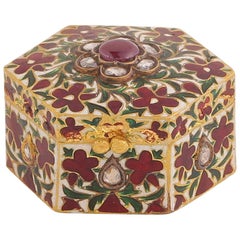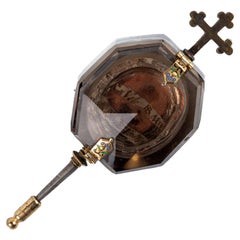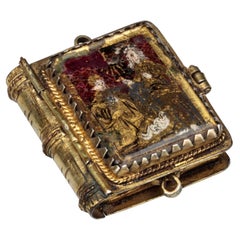16th Century Objets d'Art and Vertu
3
to
3
87
551
1,566
948
107
65
93
77
51
65
80
108
76
102
63
3
1
1
1
1
1
Period: 16th Century
Antique Double Sided Rosary Bead with Head of Christ and Skull Carved in Bone
Located in Chicago, IL
ROSARY BEAD WITH WENDEKOPF
Germany, 16th century
Bone
Weight 12 grams; dimensions 29 × 23 × 24 cm
A double-sided bead made of bone with a finely carved head of Christ on one side an...
Category
German Antique 16th Century Objets d'Art and Vertu
Antique Gold Pendant with Diamonds and Pearls
Located in Chicago, IL
Pendant with Virgin Mary as Queen of Heaven
Western Europe, Southern Germany (?), Italy (?), c. 1550-1560
Gold, enamel, diamonds, and pearls
Weight 13.2 gr; Length 36.9 x 31.2 mm (incl. pearls)
This sumptuous image exudes regal power. It portrays the Virgin Mary as Queen of Heaven wearing a dress and crown studded with seven large diamonds and set against a translucent, rich blue celestial background. Far removed from the tender, humble Virgin seen in German and Netherlandish artworks of the period, she is a majestic ruler, mouth sternly set, head tilted upward, and face in full profile.
The oval pendant cast in high gold relief with a central medallion, the single figure filling the space, echoes jewelry portraits of the aristocracy during the Renaissance, which similarly offset the ruler’s image against a blue field composed of enamel or lapis lazuli, symbolic of divine power Only the rays of the shining gold halo that emerge behind the Virgin’s head and her long flowing hair (instead of neatly coiffed) distinguish her from female ruler portraits of the period. Three studded pearls, forming an axis, also recall pendants of European rulers.
Wealth, royal status, and divine power come together in this opulent pendant. Portraits of the period show similar small oval pendants worn by women in the square of the garment or by men nestled inside multiple chains below the base of the neck.
PROVENANCE
European Private Collection
LITERATURE
Compare images from ancient Rome, for example a sardonyx cameo with female head (Kugel 2000, no. 18; Milan, c. 1550), and a pendant with gold, pearls, and enamel in the Staatliche Museum Kassel (Schmidberger/Richter 2001, no. 43; France, c. 1555-1560). For ruler pendants with blue backgrounds see a pendant of King Frances I...
Category
Antique 16th Century Objets d'Art and Vertu
Materials
Diamond, Pearl, Gold
Antique Spanish Hat Badge Pendant Carved in Jet
Located in Chicago, IL
BADGE WITH ST. JAMES THE GREAT
Northern Spain, 16th century
Silver, jet
Weight 18.2 grams; dimensions 44 × 43 × 12 mm
Round pendant with high-relief image of St. James the Great of Santiago de Compostela carved in jet. The saint is flanked by two pilgrims (their heads defaced); each holds a staff and rosary in his hand. Silver mount with plain flat backplate, corded wire surround and toothed edge as setting. Four pendant loops for sewing onto a hat or cloak.
According to the Roman naturalist Pliny, jet, the material of which this pin was made, prevented snakebite and was “thrown up by the sea.” The first quality would certainly have been reassuring for a pilgrim who owned this object and who had to make long journeys over unfamiliar terrain. The second quality made jet an especially fitting material to honor St. James, given that his body arrived in Spain mysteriously, carried there “by the sea” from the Holy Land. Santiago de Compostela was a major center
for jet carving from the late Middle Ages, and highly polished jet was a desirable and common material for pilgrimage souvenirs. One even finds scallop shells, the pilgrim’s badge...
Category
Spanish Antique 16th Century Objets d'Art and Vertu
Materials
Silver
Related Items
Enamel Box with Diamond and Rubies Handcrafted in 18 Karat Gold
By Jay Rawat
Located in Jaipur, IN
A beautiful box with fine enamel work studded with Diamonds and Rubies. Similar enamel work can be seen in Indian and Mughal jewellery from centuries ag...
Category
16th Century Objets d'Art and Vertu
Materials
Diamond, Ruby, Gold, 18k Gold, Enamel
Free Shipping
H 0.6 in W 1.11 in L 1.3 in
Sterling Silver Rosary Necklace, Catholic Rosary for Church All Sterling
Located in Austin, TX
Catholic Rosary Necklace in Sterling Silver (92.5% pure silver). This necklace is your perfect prayer and it can be worn around your neck. There is a g...
Category
American Artisan 16th Century Objets d'Art and Vertu
Materials
Sterling Silver
Antique Victorian bovine bone necklace
Located in NEWARK, GB
An interesting chunky antique Victorian bovine bone necklace.
It has large smoothed flat oval bone links or carved beads, these overlap each other slightl...
Category
British Victorian Antique 16th Century Objets d'Art and Vertu
Materials
Brass
Chinese Antique Qing Carved "Mutton Fat" Nephrite Plaque Pendant Certified
Located in Southbury, CT
Elegant, rare, and dating to the late Qing period (circa 1890s), this hand-carved nearly colorless white nephrite plaque has been etched on both sides. One one, the Chinese mythological figure known as Zhang Guo Lao is depicted riding a mule. On the opposite side, a magpie sits on a branch of cherry blossoms. The magpie is associated with intelligence. The carving is breathlessly simple and excellent; the work executed -of course- without the aid of electricity or modern tools.
Measuring 42.54mm x 29.92mm, the plaque has a hole drilled through the center, which is original to the piece. A silver bail is threaded through the hole and a pair of beads -black jade and coral- reside at the bottom. The jade plaque hands from a 1920s silver chain that is 32" in length.
Prior to the discovery of and appreciation for the very fine green jadeite from Burma, colorless, opaque, pure white nephrite jade from the Northern mountains of China was the most revered jade; the original "imperial jade, as only members of the royal court could wear or even touch it. Most of what is commercially sold today as "mutton fat...
Category
Chinese Artisan Antique 16th Century Objets d'Art and Vertu
Materials
Jade, Silver
W 1.14 in D 0.3 in L 1.68 in
Museum Quality Antique Saframpolis Safranbolu Greek Coral Enamel Silver Buckle
Located in New York, NY
A Museum Quality silver-gilt belt buckle with enamel decoration, and teardrop shaped coral and dating to circa 1830, from Saframpolis (Safranbolu...
Category
Greek Artisan Antique 16th Century Objets d'Art and Vertu
Materials
Coral, Silver, Enamel
LB Vintage Resin Crystal Bone and Wood Bead Necklace on offer
By Lorraines' Bijoux
Located in Pittsburgh, PA
Lorraine’s Bijoux offers a one of a kind, handmade, Vintage Resin, Faceted Crystal,Vintage Bone, and Wood Chunky Stunning Necklace. This is a wonderful piece to accent and update any...
Category
American Artisan 16th Century Objets d'Art and Vertu
Materials
Crystal, Sterling Silver
Antique Russian Gold and Guilloche Enamel Easter Egg Pendant, 19th Century
Located in New York, NY
Antique Russian Gold and three color guilloche enamel Easter egg pendant. The geometric design of this beautiful pendant focuses on the number 8, a number associated with infinity, spiritual balance and a symbol of new beginnings. At the top and base of this egg are a pair of cobalt blue enamel eight pointed stars, each surrounded by eight verdant green enamel butterfly shaped sections which expand into eight central sky blue enamel stylized figure eight lozenges. The entire piece in the guilloche enamel technique, topped by a gold bow ribbon which is hallmarked in the center 56. Traditionally, Russian Easter...
Category
Russian Russian Empire Antique 16th Century Objets d'Art and Vertu
Materials
Gold, Enamel
Double Strand Lapis Bead Necklace
Located in Solvang, CA
Estate double strand lapis bead necklace. This necklace features two strands of knotted lapis beads with a 14 karat yellow gold clasp. [RHAW 59]
Dimensions
18″L; 6.3mm beads
Category
16th Century Objets d'Art and Vertu
Materials
Lapis Lazuli, 14k Gold, Yellow Gold
Antique Victorian English Essex Crystal Gold Dog Pug Stickpin
Located in Munich, Bavaria
The wonderful carved Essex Chrystal stickpin of a pug is mounted in gold. The reverse carved ad painted crystal has been executed in England in 1865 ca. The pug wears a collar with a...
Category
Victorian Antique 16th Century Objets d'Art and Vertu
Materials
Crystal, 15k Gold
Old or Antique Italian Silver & Enamel Compact with its Original Box
Located in Philadelphia, PA
A fine antique Italian compact.
In 800 silver.
With enamel decoration depicting two women in a forest with a dog - one playing a guitar while the oth...
Category
Italian Renaissance Revival 16th Century Objets d'Art and Vertu
Materials
Silver, Enamel
Free Shipping
H 0.38 in W 3 in D 3.13 in
Wonderful Victorian Antique Hardstone Gold Filled Watch Fob
Located in Wheaton, IL
The piece on display is an absolute marvel of craftsmanship that is bound to leave you in awe. It is a testament to the skilled artisans who created it, showcasing elaborate and deta...
Category
Victorian 16th Century Objets d'Art and Vertu
Materials
Gold-filled
Antique Georgian Hand-Carved Natural Coral Bead Tassel Lariat
Located in Stamford, CT
Each bit of Georgian coral in this lariat has been carved and polished by hand and is buttery soft to the touch, making it a breed apart from new coral....
Category
Italian Georgian Antique 16th Century Objets d'Art and Vertu
Materials
Coral
Previously Available Items
XVI Century Quartz & Gold Reliquary with Cross in Yellow Gold
Located in Bilbao, ES
XVI Century in Quartz Fumé crowned with Cross in Yellow Gold.
Faceted octogonal case with hinge and lock in Yellow Gold
Inside Silver Reliquary with ...
Category
Antique 16th Century Objets d'Art and Vertu
Materials
Quartz, Yellow Gold, Silver
Antique Gilded Silver Renaissance Reliquary Pendant in Book Form
Located in Chicago, IL
Reliquary Pendant in Book Form
Southern Germany, probably Augsburg, c. 1550
Gilded silver, verre églomisé
Weight 14.1 grams; dimensions 35 × 29 × 13 mm
Gilded silver pendant in book form with hinged lid, corded wire surround, and engraved spine. The front cover of the book is set with a glass plaque depicting the Nativity in verre églomisé; the back cover shows the Annunciation. When opened, inside is Christ as Ecce Homo under a trefoiled arch, and opposite is a relic (missing) surrounded by a golden aureole against a red background. Trefoil-shaped pendant loop on top and bottom, and book clasp.
Nothing could be more satisfying, intellectually and devotionally, than combining the functions of the personal reliquary and the book. One opens and looks into either with the expectation of encountering knowledge and truth. In the case of this tiny book, there are no words, only pictures, but ample satisfaction nonetheless derives from the revelation of the holy images and perhaps even the material presence of a relic secreted within the tiny, precious covers.
The fashion for miniature book jewels seems to have emerged in the sixteenth century. Romina
Ebenhoech has identified eight very similar surviving examples with verre églomisé images. The three examples in this collection represent a significant proportion of the surviving corpus.
An early publication on the book pendants suggested that the metal frames and the inset reverse-painted glass were manufactured separately, which could well be the case. If so, the individual books may represent a personalized devotional object with four images selected by the patron, each a separate jewel painted in red and white and glowing with gold. In his Autobiography, Benvenuto Cellini recommended gold-glass reverse painting as an appropriate medium for the production of reliquaries. It responds especially well to the flickering nature of candlelight (as on altars).
In this example, the front of the book represents the Nativity and the back the Annunciation, inverting the narrative order, but perhaps satisfying devotional needs. The patron might have wished to have the Nativity as the primary image—especially appealing here in the Bridgettine vision of Mary praying before the newborn Christ, who glows brighter than any light, even the candle held by St. Joseph.
Opening the book, however, triggers a different mode of more affective devotion. Confronting the viewer at the core of the little book is the body of Christ. This is the Ecce Homo, the moment in the Gospel story when Christ was presented before Pontius Pilate. The image gained currency after 1500, following the format of the Man of...
Category
German Renaissance Antique 16th Century Objets d'Art and Vertu
Materials
Silver, Gilt Metal
Free Shipping
W 1.15 in D 0.52 in L 1.38 in
Read More
How to Identify Real Capodimonte Porcelain
Early examples by the Italian manufacturer can be hard to come by, but the best later pieces possess the same over-the-top charm.
Ask an Interior Designer: Work-from-Home Edition
Leaping into a design project, whether it's refreshing the bedroom or redoing the whole house, can be overwhelming. Luckily, we know more than a few interior designers. You asked questions on Instagram, and now they're answering.
Recently Viewed
View AllMore Ways To Browse
Silver Tiffany Pens
Purse Mesh Diamond
Dunhill 18k
Golf Clip
Tiffany Sterling Silver Key Ring
Antique Powder Puff
Cartier Lighter Diamonds
Rolex Saudi
Rolex Watch School
Rolex Watch On Wish
Tiffany Sterling Key Ring
Baby Rolex
Babies Rolex
Cartier Ashtray
Rolex Board
Baby Rolex Watch
Tiffany And Co Silver Pen
Tiffany Co Silver Pen



